Nicknamed the Grand Canyon State, Arizona is famous for its stunning landscapes but is also a big player in American agriculture. You may be surprised to learn that the state is more than just desert. In fact, it has fertile lands that grow various valuable crops. From fruits and vegetables to grains and livestock, Arizona’s farmers are hard at work year-round.
Curious about what crops bring in the most money for the state? We’ve compiled a list of Arizona’s top money-making crops to give you an idea. Keep reading to find out which crops are the most valuable in Arizona!
Disclaimer: All figures come from the United States Department of Agriculture – National Agricultural Statistics Service (USDA-NASS) and are accurate as of 2022. However, data may change due to updates or revisions by USDA-NASS. You should verify the information for specific needs and consult USDA-NASS for the latest data.
1. Hay & Haylage – $742,587,000
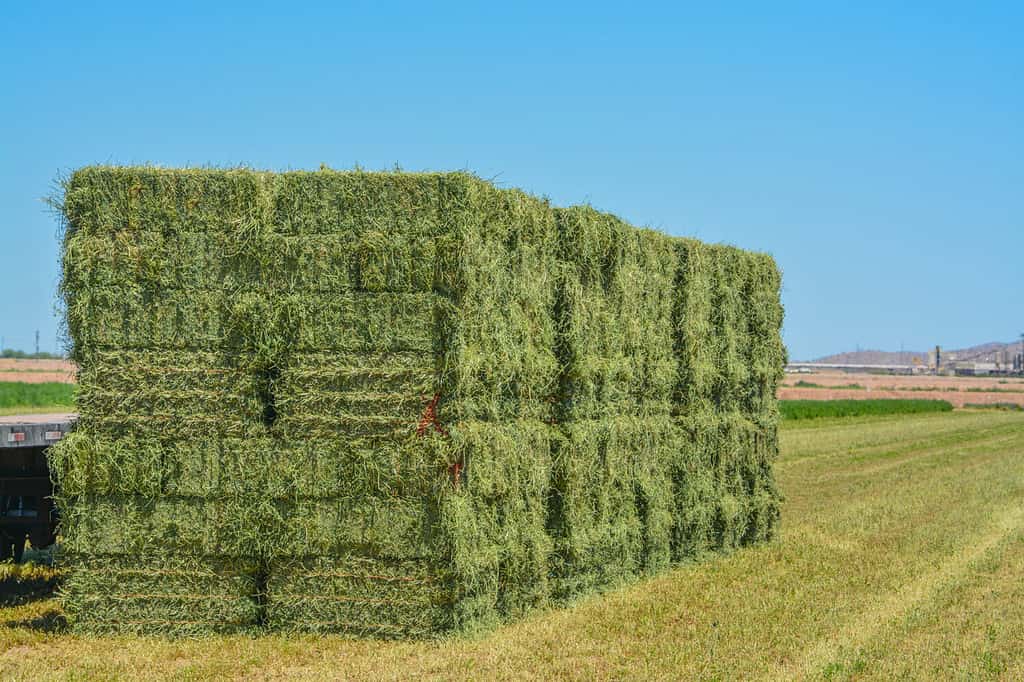
Hay — alfalfa hay, in particular — is the most valuable crop in Arizona, with the state producing more than $700 million worth of the crop.
©Norm Lane/Shutterstock.com
When it comes to the most valuable crops in Arizona, hay and haylage take the lead.
Hay, an essential part of agriculture, consists of dried grasses and other plant materials used as animal feed. Typically, these plants are harvested while still green. Then, they are either air-dried in the field or dried using forced hot air. Common hay crops include timothy, alfalfa, and clover.
On the other hand, haylage is essentially grass that’s harvested at a younger stage of growth compared to hay. Instead of being fully dried out, it’s allowed to wilt partially.
One standout among these crops is alfalfa, a leafy legume hay often added to livestock’s diets for its rich nutritional value. Unlike other grass hays, alfalfa contains significantly more protein, making it an important dietary addition for certain animals.
In the desert valleys of Arizona, hay is cultivated year-round using groundwater sourced from the Colorado River. Interestingly, a significant portion of this hay is exported to provide animal food in Saudi Arabia and the United Arab Emirates.
For almost a decade now, Arizona has leased rural land west of Phoenix, AZ, to a Saudi company to grow alfalfa hay. They have access to the water they need. Also, this crop serves as an essential food source for Saudi Arabia’s dairy cows.
In 2022, the combined production value of hay, haylage, and alfalfa in Arizona reached a staggering $742,587,000. However, the lion’s share of this profit came from alfalfa alone, totaling around $682 million in value.
Notably, in the same year, Arizona produced a whopping 2,391,000 tons of hay, which includes alfalfa.
Recent statistics for 2023 forecast that the total production of hay and alfalfa in Arizona has reached 2,283,000 tons. This underscores the vital role these crops play in the state’s agricultural landscape.
2. Lettuce – $442,740,000

The majority of the romaine lettuce in Arizona grows in Yuma County, an area with a reputation for agriculture.
©Firn/iStock via Getty Images
Romaine lettuce takes the second spot as one of Arizona’s most valuable crops.
This particular type of lettuce has long, upright, and crisp leaves with a distinct midrib that runs almost to the tip. The tips of the leaves are round, and they tend to have a somewhat folded or cupped shape. When grown in loose heads, the inner leaves are more delicate and blanched compared to the outer ones.
A vast majority, around 95%, of the lettuce produced in Arizona takes place in the lower Colorado River and Gila River Valleys of Yuma County. This area, situated at an elevation of below 100 feet, experiences mild winters and hot summers. Summers average around 87°F, while winters are a cooler 55°F. With the added advantage of the Colorado River and favorable soil conditions, this region provides ideal conditions for growing lettuce.
More than 90 percent of all lettuce production in the United States comes from California and Arizona (with Arizona producing 30% and California producing 70%). Lettuce grows year-round in the United States thanks to a production sequence that involves both Arizona and California.
In 2022, Arizona contributed significantly to the lettuce industry, producing lettuce worth an impressive $442,740,000. To put this in perspective, that’s roughly equivalent to the combined weight of 7,050,000 hundredweight units (CWT). Lettuce heads alone accounted for a substantial $373,815,000.
As you can see, Arizona stands proudly as the second-largest lettuce producer in the country, trailing only behind California. It is consistently one of Arizona’s top cash crops, with an average annual value of over $300 million!
3. Spinach – $150,024,000
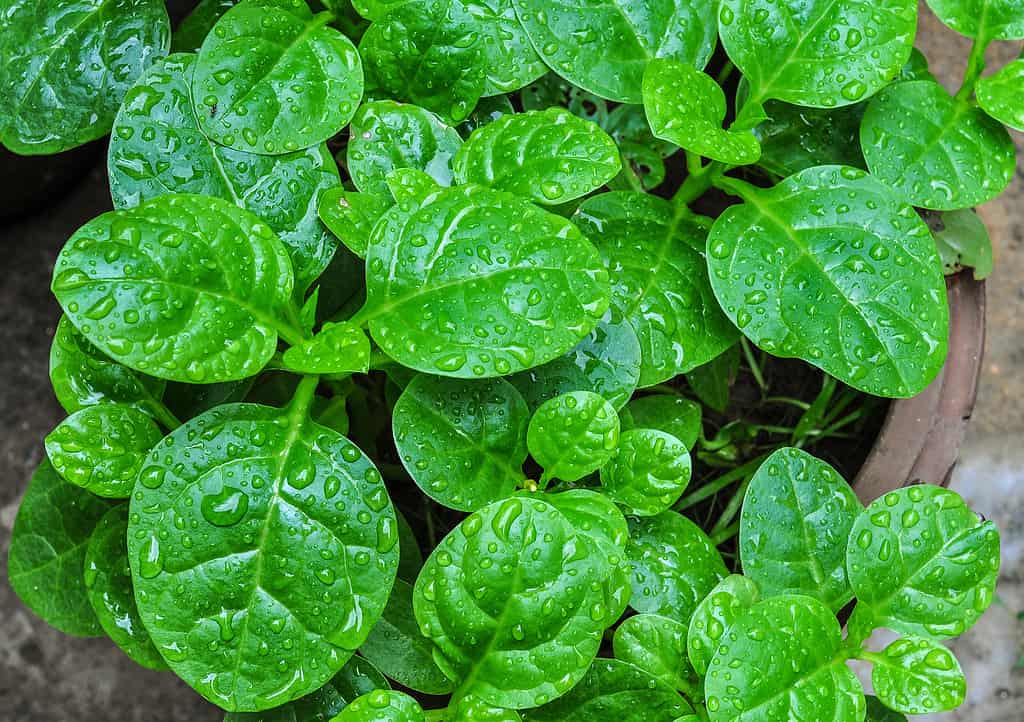
The third most valuable crop in Arizona is spinach, a leafy green plant that people can eat raw or cooked in various preparations.
In the world of Arizona’s most valuable crops, delicious and versatile spinach claims the third spot!
In Arizona, spinach cultivation takes place during the fall and winter seasons. The process begins in early October and extends through to the middle of February. This specific planting and harvesting schedule ensures a successful spinach crop in the region.
Spinach is a leafy green plant with a rosette of green leaves, enjoyed both raw and cooked. Its leaves have a distinctive oval shape, often wrinkled, and can be whole or chopped. Spinach is not only delicious but also highly nutritious and easy on the stomach. In fact, in the past, the Arabs regarded it as the queen of vegetables. And it’s easy to see why!
When it comes to spinach production in the United States as a whole, a whopping 90% of it happens in California and Arizona. And in terms of what type of spinach the state grows, in Arizona’s Yuma and Maricopa Counties, popular spinach varieties like ‘Rushmore’ and ‘Bossa Nova’ thrive.
In the year 2022, Arizona achieved an impressive spinach production worth $150,024,000. To put that in perspective, this equates to a whopping 2,128,000 CWT.
To achieve this, approximately 11,200 acres of land were dedicated to spinach farming in Arizona during 2022. In spinach production, only California surpasses Arizona in terms of output.
4. Cotton – $122,400,000
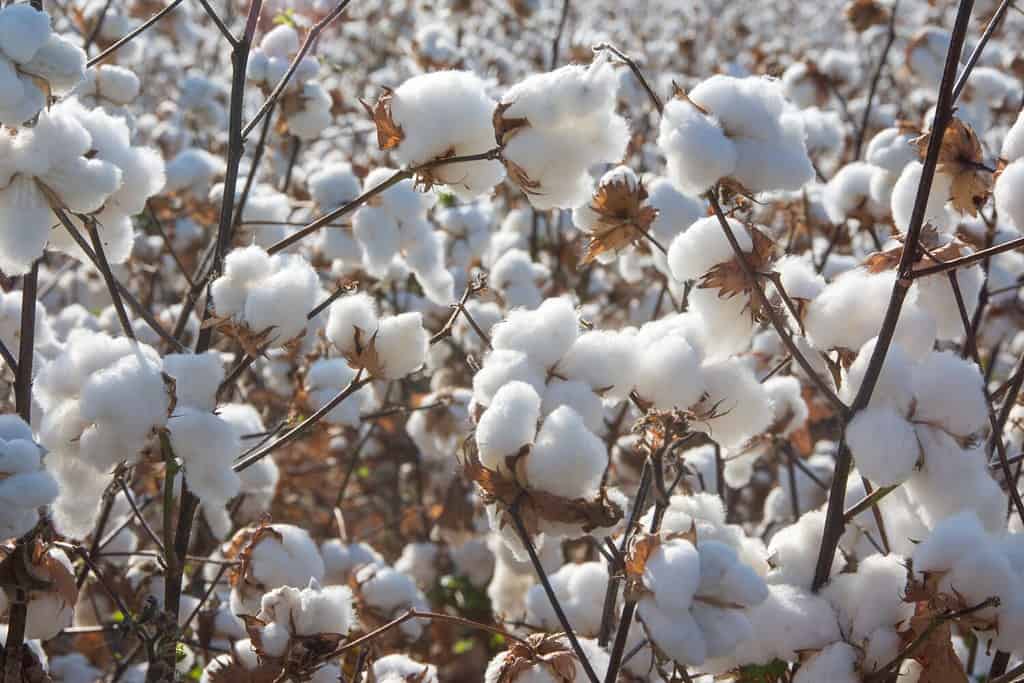
Thanks to the minimal rainfall in the arid climate of Arizona, cotton thrives in this state, as well as in California.
©Diana Borden/Shutterstock.com
Ranked fourth on the list of Arizona’s most valuable crops is cotton! Arizona, alongside California, produces some of the purest and highest-quality cotton available. This excellence is largely due to the irrigation practices in both states. With minimal rainfall in the arid Southwest, the quality of cotton fibers remains uncompromised, unaffected by wind and rain.
Interestingly, right here in Arizona, one of the finest extra-long staple (ELS) cotton varieties has been developed and cultivated.
Cotton, as a staple fiber, comprises different lengths of fibers, each with its own unique characteristics. Cotton fibers are naturally hollow, lending them softness, breathability, and absorbency. Remarkably, they can hold water up to 24 to 27 times their weight! Cotton is used for a variety of fabric purposes, such as to create t-shirts, jeans, jackets, and even baby items. This fiber is also used to create fabrics like flannel, velour, velvet, corduroy, and denim!
The history of cotton in Arizona dates back over 2,000 years when it migrated north from Mexico. Archaeological evidence reveals cotton cultivation, cloth production, and the use of cottonseed in southern Arizona as early as 400 BC, with the Desert Culture, and continued with the Hohokam and subsequent Native American communities.
In 2022, the cotton industry in Arizona generated an impressive $122,400,000 in value. That is equivalent to a weight of 308,000 480-pound bales. This accomplishment required approximately 102,000 acres of land dedicated to cotton cultivation in Arizona during that year.
Recent data up to August 2023 shows that Arizona has produced a total of 249,000 480-pound bales of cotton, highlighting the continued significance of this crop in the state’s agriculture.
5. Broccoli – $121,394,000
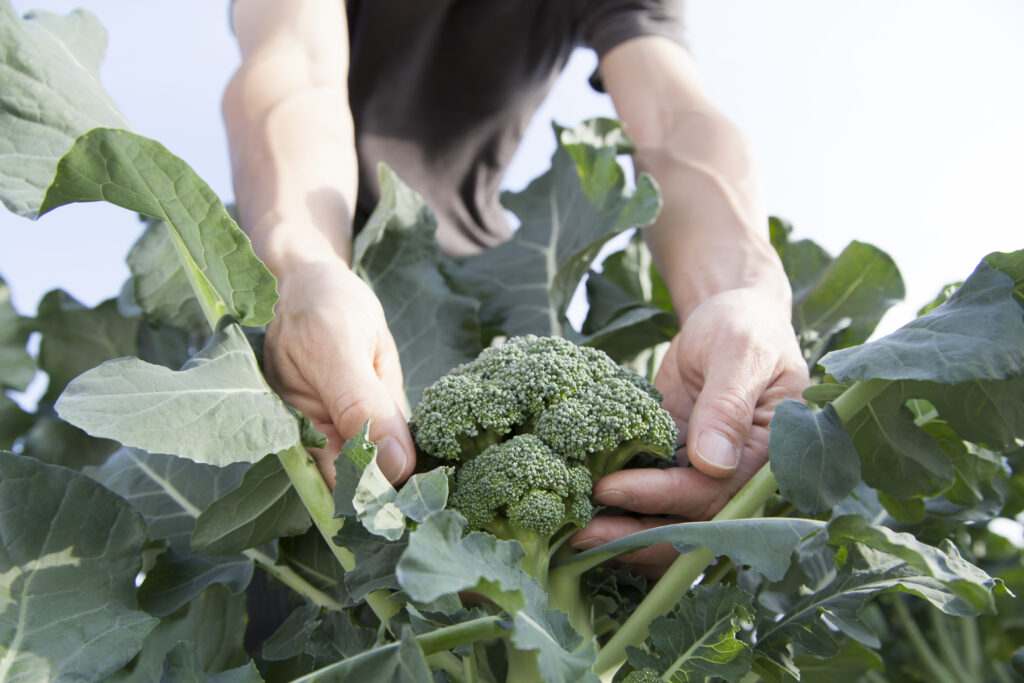
The two states that lead in the production of broccoli are California and Arizona, with Arizona producing more than $100 million worth in 2022.
©Alexander Knyazhinsky/Shutterstock.com
Not far behind cotton, broccoli holds its place among the top five most valuable crops in Arizona! Broccoli ranks high as one of the leading vegetables grown in the state.
Fresh broccoli is easily identifiable by its deep green color, firm stalks, and tightly packed bud clusters. This fast-growing annual plant typically reaches a height of 24 to 35 inches. Its upright, branching structure features sturdy leaves, and it produces dense clusters of green flower buds at the tips of its central stem and branches.
Broccoli enjoys its status as one of America’s favorite vegetables, and Arizona is the second-largest producer in the country, trailing only behind California once again.
In Arizona, as a cool-season crop, broccoli thrives during the fall, winter, and spring seasons. Planting can commence as early as mid-August and typically wrap up by the start of December. Similar to spinach, broccoli finds its primary home in Maricopa and Yuma counties.
In 2022, Arizona reaped substantial rewards from broccoli production, with earnings totaling $121,394,000. To achieve this, farmers cultivated broccoli on approximately 11,600 acres of land in the state, yielding a remarkable 1,508,000 CWT of this beloved vegetable!
6. Wheat – $109,166,000

The sixth most valuable crop in Arizona in 2022 is wheat, one of the three most important food grains for humans.
©Khawaja gulam fareed/Shutterstock.com
Wheat stands as another valuable crop in the Grand Canyon State, thanks to its cultivation in desert valleys and lowlands using irrigation. These regions experience high temperatures and minimal rainfall, making them ideal for wheat production.
Notably, Arizona specializes in growing durum wheat, a lesser-known fact is that it’s a key ingredient in Italian pasta, thanks to the dedicated efforts of Arizona plant experts who have spent years perfecting this wheat variety through seed breeding.
One of the world’s most important food grains for humans, wheat is an annual grass typically planted towards the end of summer. It survives the winter and then starts its growth and maturation as spring transitions into summer. Wheat has a bunch-like growth pattern with upright tillers.
One significant advantage of cultivating wheat in the low desert of Arizona is the ability to consistently produce high-quality wheat year after year. This stands in contrast to regions like North Dakota, where unpredictable weather conditions can pose challenges for maintaining consistent wheat quality.
In the previous year, Arizona’s wheat production reached a value of $109,166,000, and this achievement required the use of approximately 85,000 acres of land. This is around 9,576,000 bushels of wheat.
Recent data up to August 2023 indicates a wheat production of 5,292,000 bushels in the state, reaffirming the continued significance of wheat in Arizona’s agriculture.
7. Pecans – $94,622,000

From roughly 23,000 acres of land, Arizona produced an incredible 94 million dollars worth of pecans.
©iStock.com/Say-Cheese
Taking the seventh spot on the list of Arizona’s most valuable crops, we find pecans! In the nationwide ranking of pecan production, Arizona secures a respectable fourth place, trailing behind New Mexico, Georgia, and Texas.
A significant factor contributing to the growth of pecan production in Arizona is the availability of more affordable land and water resources. The state holds certain advantages over pecan-producing regions in the southeast, primarily its climate, which helps ward off some pest and disease challenges often seen in more humid and wet areas.
In Arizona, there are roughly 26,000 acres of pecan orchards, with 14,000 acres actively producing pecans.
Pecans, tree nuts belonging to the hickory family, offer a delightful crunch and a sweet, rich flavor. Their exceptional taste places them in high regard in the culinary world. They are frequently featured in gourmet nut mixes or coated with sugar and spices before being baked into special snacks or desserts.
Moreover, the United States is one of the largest consumers of pecans globally, emphasizing the significance of this nut in the country.
In 2022, Arizona’s pecan production reached an impressive value of $94,622,000, with approximately 23,000 acres of land dedicated to pecan harvesting. That’s a total of 39,100,000 pounds of pecans!
8. Cauliflower – $79,596,000
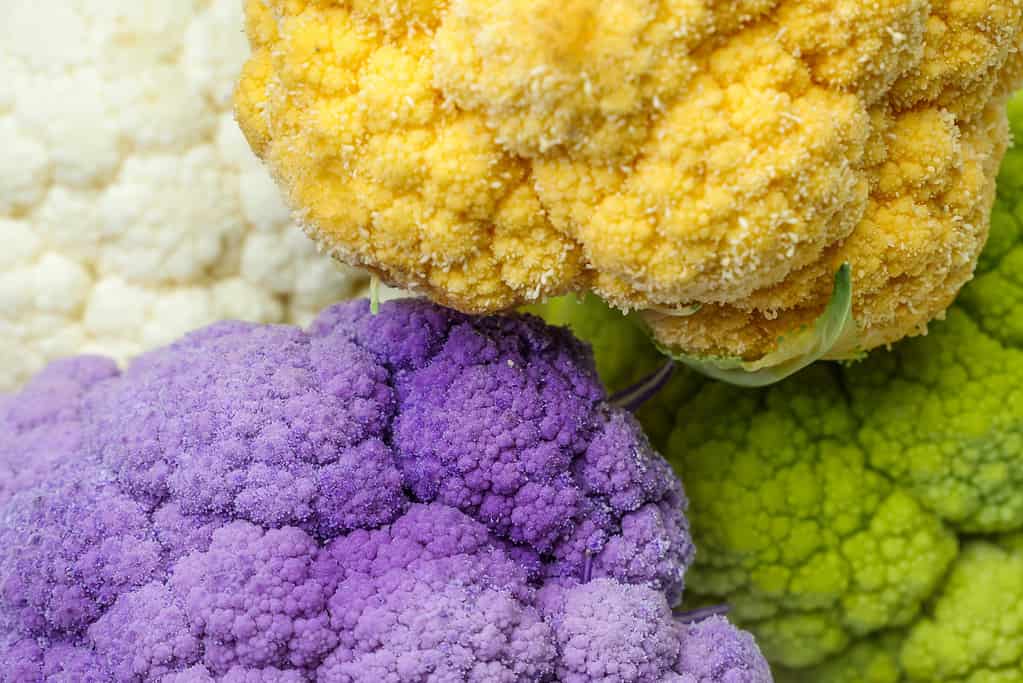
Cauliflower, the eighth most valuable crop in Arizona, comes in many more colors than simply white!
©Animaflora/iStock via Getty Images
Last on the list of valuable crops in Arizona is cauliflower!
During the fall season, the most common cauliflower variety grown in Arizona is ‘Minute Man.’ This choice is due to its rapid maturation, requiring only 75 to 80 days after transplanting to produce a market-ready head. However, it’s essential to note that this variety is suitable primarily for desert production.
In the United States, California takes the lead as the major cauliflower-producing state, with Arizona following closely behind as the second-largest producer. Together, these two states account for a substantial 93 percent of fresh cauliflower acreage in the country.
Cauliflower plants are annual and typically grow to a height of about 1.5 feet. They feature large, rounded leaves resembling collards. While white is the most common color, cauliflower can come in various other hues, including purple, yellow, green, and orange.
Yuma County is the primary hub for cauliflower production in Arizona, but it is also produced in La Paz, Maricopa, Pima, and Pinal. As with most crops in the state, irrigation plays a pivotal role in determining both yield and quality.
In the previous year, Arizona achieved a noteworthy cauliflower production worth $79,596,000. This substantial output required the cultivation of cauliflower on around 5,400 acres of land, resulting in approximately 1,080,000 CWT.
Summary of Arizona’s Top 8 Most Valuable Crops
| Rank | Crop | Value (2022) |
|---|---|---|
| 1. | Hay & Haylage | $742,587,000 |
| 2. | Lettuce | $442,740,000 |
| 3. | Spinach | $150,024,000 |
| 4. | Cotton | $122,400,000 |
| 5. | Broccoli | $121,394,000 |
| 6. | Wheat | $109,166,000 |
| 7. | Pecans | $94,622,000 |
| 8. | Cauliflower | $79,596,000 |
The photo featured at the top of this post is © Firn/iStock via Getty Images
Thank you for reading! Have some feedback for us? Contact the AZ Animals editorial team.







